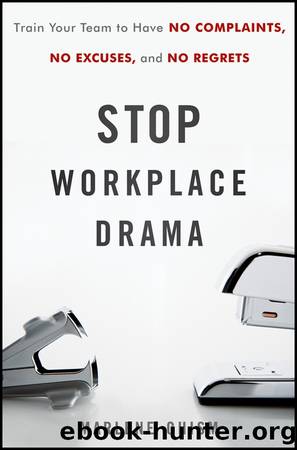Stop Workplace Drama by Marlene Chism

Author:Marlene Chism
Language: eng
Format: epub
Publisher: Wiley
Published: 2010-12-28T00:00:00+00:00
Simplified Snapshot
Per the Karpman Triangle model, the victim feels helpless, the rescuer has the answer, and the persecutor tells you whose fault it is. So, if you have an employee who constantly plays the victim role, you will likely hear stories about why life is hard or unfair, or constant complaints and excuses why they are unable to change. This fundamental belief helps the employees create and support self-defeating patterns that prove that they are rightâlife really is hardâand keep them stuck in their current roles.
The victim pattern can be subtle and sometimes difficult to recognize, even if you are a very responsible person overall. I had many victim beliefs when I worked in the factory before starting my professional career. It was difficult for me to even imagine having a different careerâa belief that kept me from even attempting to attend college until I was in my thirties.
When people first learn about the Triangle, they find that they identify with a particular role. Most leaders identify most with the rescuer role; after all, in order to be a leader, you canât be operating from the victim orientation every day.
An overview of each of the roles is given below. See with which one you identify most as you think about your relationships and the areas where you experience drama. Letâs start with the rescuer role.
Figure 5.1 The Karpman Drama Triangle
Download
This site does not store any files on its server. We only index and link to content provided by other sites. Please contact the content providers to delete copyright contents if any and email us, we'll remove relevant links or contents immediately.
| Conflict Resolution & Mediation | Human Resources & Personnel Management |
| Knowledge Capital | Outsourcing |
Bullshit Jobs by David Graeber(4094)
Radical Candor by Kim Scott(2667)
I Am Right, You Are Wrong by Edward De Bono(2420)
23:27 by H. L. Roberts(2195)
Nomadland by Jessica Bruder(2013)
Average Is Over by Tyler Cowen(1801)
The Conflict Resolution Phrase Book by Barbara Mitchell & Cornelia Gamlem(1734)
Out of Our Minds: Learning to Be Creative by Ken Robinson(1688)
High-Impact Interview Questions by Victoria A. Hoevemeyer(1662)
Who Moved My Cheese?: An Amazing Way to Deal With Change in Your Work and in Your Life by Johnson Spencer(1615)
The Ideal Team Player by Patrick M. Lencioni(1607)
An Everyone Culture: Becoming a Deliberately Developmental Organization by Robert Kegan & Lisa Laskow Lahey(1596)
The Asshole Survival Guide by Robert I. Sutton(1559)
Automatic Society by Bernard Stiegler(1511)
Unleashed by Anne Morriss & Frances Frei(1492)
Who by Street Randy & Smart Geoff(1468)
42 Rules of Employee Engagement by Susan Stamm(1438)
96 Great Interview Questions to Ask Before You Hire by Paul Falcone(1399)
Fish! by Stephen C. Lundin(1343)
